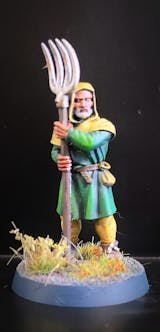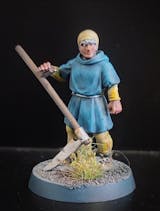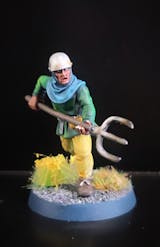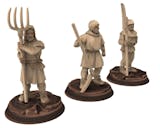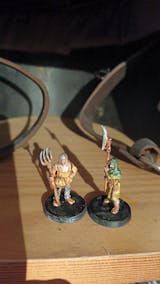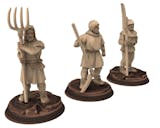Printed in solid non-hollowed resin (no holes).
Good quality resin (40€/kg).
Bases not supplied.
Randomly packaged.
28mm scale (for SDA/D&D).
These models were made by Medbury miniatures and are sold under license.
https://www.patreon.com/medburyminiatures/posts
Peasant levies were a common feature of Medieval armies. They were made up of untrained, inexperienced peasants. Peasant levies were often called upon during times of war or crisis. They were usually drafted into the army by their local lord or monarch.
Peasant levies were particularly effective when fighting on their own terrain. For example, they were often used as archers or skirmishers in battles fought in hilly or forested areas. Peasant levies were also sometimes used to defend castles or other fortified positions.
In these situations, they could provide a valuable source of manpower for the garrison.
Peasant levies were often armed with makeshift weapons such as pitchforks or clubs. Their lack of training and equipment made them less effective in battle than professional soldiers. However, peasant levies could provide a large number of troops quickly and at a low cost.
The use of peasant levies was particularly common in the early Middle Ages. As feudalism developed, the role of peasant levies in armies declined. This was due to the increasing professionalization of armies and the rise of the knightly class.
Nevertheless, peasant levies continued to be used in some parts of Europe throughout the Middle Ages. In some cases, they were incorporated into larger professional armies. In other cases, they were used as a last resort when other troops were not available.
Peasant levies were often poorly treated by their commanders and fellow soldiers. They were sometimes seen as inferior or disposable. Despite this, some peasant levies fought bravely and made significant contributions to their armies.
The use of peasant levies could also have political implications. Drafting peasants into the army could be seen as a way for lords or monarchs to demonstrate their power. It could also help to reinforce social hierarchies by emphasizing the subordinate status of peasants.
The role of peasant levies in Medieval armies was not uniform across Europe. Different regions and kingdoms had their own traditions and practices. Some areas relied heavily on peasant levies, while others used them only sparingly.
The availability of other types of troops, such as mercenaries or knights, also played a role. The use of peasant levies declined as firearms became more widespread in the late Middle Ages. Firearms required specialized training and equipment, which peasants were unlikely to possess. As a result, peasant levies gradually disappeared from European armies by the end of the Middle Ages.









